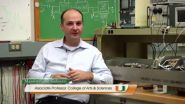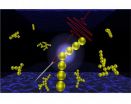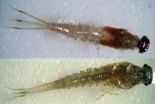(Press-News.org) VIDEO:
Dr. Massimilano Galeazzi discusses his work on a sounding rocket, sent into the atmosphere to search for answers about the universe.
Click here for more information.
CORAL GABLES, Fla. (July 27, 2014) — When we look up to the heavens on a clear night, we see an immense dark sky with uncountable stars. With a small telescope we can also see galaxies, nebulae, and the disks of planets. If you look at the sky with an X-ray detector, you would see many of these same familiar objects; in addition, you would see the whole sky glowing brightly with X-rays. This glow is called the "diffuse X-ray background."
While, at higher energies, the diffuse emission is due to point sources too far away and faint to be seen individually, the origins of the soft X-ray glow have been controversial, even 50 years after it was first discovered. The long-standing debate centers around whether the soft X-ray emission comes from outside our solar system, from a hot bubble of gas called the local hot bubble, or whether the emission comes from within the solar system, due to the solar wind colliding with diffuse gas.
New findings settle this controversy. A recent study shows that the emission is dominated by the local hot bubble of gas (1 million degrees), with, at most, 40 percent of emission originating within the solar system. The findings, published in the journal Nature, should put to rest the disagreement about the origin of the X-ray emission and confirm the existence of the local hot bubble.
"We now know that the emission comes from both sources, but is dominated by the local hot bubble," said Massimiliano Galeazzi, professor and associate chair in the Department of Physics in the College of Arts and Sciences, at the University of Miami (UM) and principal investigator of the study. "This is a significant discovery. Specifically, the existence or nonexistence of the local bubble affects our understanding of the area of the galaxy close to the Sun, and can, therefore, be used as a foundation for future models of the galaxy structure."
Galeazzi, who led the investigation, and his collaborators from NASA, the University of Wisconsin-Madison, the University of Michigan, the University of Kansas, the Johns Hopkins University and CNRS in France, launched a sounding rocket mission to analyze the diffuse X-ray emission, with the goal of identifying how much of that emission comes from within our solar system and how much from the local hot bubble.
"The DXL team is an extraordinary example of cross-disciplinary science, bringing together astrophysicists, planetary scientists, and heliophysicists," said F. Scott Porter, astrophysicist at NASA's Goddard Space Flight Center. "It's unusual but very rewarding when scientists with such diverse interests come together to produce such groundbreaking results."
The study measured the diffuse X-ray emission at low energy, what is referred to as the 1/4 keV band, corresponding to radiation with wavelength of the order of 5 nm.
"At that low energy, the light gets absorbed by the neutral gas in our galaxy, so the fact that we observe it means that the source must be 'local,' possibly within a few hundred light-years from Earth. However, until now it was unclear whether it comes from within the solar system (within few astronomical units from Earth), or a very hot bubble of gas in the solar neighborhood (hundreds of light-years from Earth). This is like traveling at night and seeing a light, not knowing if the light comes from 10 yards or 1,000 miles away," Galeazzi said.
Interstellar bubbles are probably created by stellar winds and supernova explosions, which cast material outward, forming large cavities in the interstellar medium—the material that fills the space between the stars in a galaxy. Hot X-ray emitting gas can fill the bubble, if a second supernova occurs within the empty cavity.
X-ray emission also occurs within our solar system when the solar wind collides with interplanetary neutral gas. The solar wind is a stream of charged particles released, with great energy, from the atmosphere of the sun. They create a solar wind that travels vast distances, forming a region called the heliosphere. As these particles travel through space at supersonic speeds, they may collide with neutral hydrogen and helium that enters the solar system due to the motion of the sun in the galaxy, capturing an electron and emitting X-rays. This is called the solar wind charge exchange process.
The team refurbished and modernized an X-ray detector that was mounted on a sounding rocket. The X-ray detector was originally flown by the University of Wisconsin-Madison on multiple missions during the 1970s to map the soft X-ray sky. The current team, led by Galeazzi, rebuilt, tested, calibrated, and adapted the detectors to a modern NASA suborbital sounding rocket. Components from a 1993 Space Shuttle mission were also used. The sounding rocket mission, known as "The Diffuse X-ray emission from the Local Galaxy," aimed at separating and quantifying the X-ray emission from the two suspected sources: the local hot bubble and the solar wind charge exchange. This was the first mission designed for this kind of study.
"X-ray telescopes on satellites can observe for long periods of time and have reasonably large collecting areas, but very tiny fields of view, so they are very good for studying a small area in great detail," said Dan McCammon, professor of Physics at the University of Wisconsin-Madison and one of the scientists who built the original instrument. "However, the observations for this experiment needed to look at a large part of the sky in a short time, to make sure the Solar wind did not change during the measurements. The sounding rocket could do it 4000 times faster."
The rocket was launched with the support of NASA's Wallops Flight Facility, from White Sands Missile Range in New Mexico, on December 12, 2012. It reached an altitude of 258 km (160 miles), and stayed above the Earth's atmosphere for five minutes, enough time to carry out its mission successfully. The information collected was transmitted directly to researchers on the ground at the launch facility.
"The sounding rocket program allows us to conduct high-risk, high-payoff science quickly and inexpensively," Porter said. "It is really one of NASA's crown jewels."
Galeazzi and collaborators are already planning the next launch. The next mission will be similar in design and goals, but will have multiple instruments to characterize the emission in more detail. The launch is currently planned for December, 2015.
INFORMATION:
The results of the study appear in an article in the journal Nature, titled "The origin of the 'local' ¼ keV X-ray flux in both charge exchange and a hot bubble." Other authors are M. Chiao, M.R. Collier, F. S. Porter, S. L. Snowden, N. E. Thomas and B. M. Walsh, from NASA's Goddard Space Flight Center; T. Cravens and I. Robertson, from Department of Physics and Astronomy, University of Kansas; D. Koutroumpa, from Universitè Versailles St-Quentin; Sorbonne Universitès & CNRS/INSU, LATMOS-IPSL; K.D. Kuntz, from The Henry A. Rowland Department of Physics and Astronomy, Johns Hopkins University; R. Lallement, from GEPI Observatoire de Paris, CNRS, Université Paris Diderot; S. T. Lepri from the Department of Atmospheric, Oceanic, and Space Sciences, University of Michigan; D. McCammon and K. Morgan, from the Department of Physics, University of Wisconsin-Madison; and Y. Uprety and E. Ursino, from the UM Department of Physics.
The study was made possible with support from NASA. In addition, the collaborators in France received support from: Soleil Héliosphère Magnétosphère" of the French space agency CNES, and the National Program "Physique Chimie du Milieu Interstellaire" of the Institut national des sciences de l'univers, INSU.
The University of Miami's mission is to educate and nurture students, to create knowledge, and to provide service to our community and beyond. Committed to excellence and proud of our diversity of our University family, we strive to develop future leaders of our nation and the world.
Glow in space is evidence of a hot bubble in our galaxy
University of Miami scientist led a NASA rocket mission to measure the diffuse X-ray background in space, revealing a 'local hot bubble'
2014-07-28
ELSE PRESS RELEASES FROM THIS DATE:
Interfering with interferon
2014-07-28
Using the body's natural virus killers to prevent and treat HIV infection has been problematic until now because of the strong inflammatory response these molecules can arouse as they get rid of the invaders. Now, collaborative research conducted by scientists at the Weizmann Institute and the National Institutes of Health (NIH) have demonstrated how suppressing the activity of these molecules – interferons – around the time of infection could have long-term implications for the course of the disease. Their research appeared in Nature.
Interferons, named for their ability ...
Industrial lead pollution beat explorers to the South Pole by 22 years and persists today
2014-07-28
RENO – Norwegian explorer Roald Amundsen became the first man to reach the South Pole in December of 1911. More than 100 years later, an international team of scientists led by Joe McConnell of Nevada's Desert Research Institute (DRI) have proven that air pollution from industrial activities arrived long before.
Using data from 16 ice cores collected from widely spaced locations around the Antarctic continent, including the South Pole, McConnell's team created the most accurate and precise reconstruction to date of lead pollution over the Earth's southernmost continent. ...
Building 'invisible' materials with light
2014-07-28
A new method of building materials using light, developed by researchers at the University of Cambridge, could one day enable technologies that are often considered the realm of science fiction, such as invisibility cloaks and cloaking devices.
Although cloaked starships won't be a reality for quite some time, the technique which researchers have developed for constructing materials with building blocks a few billionths of a metre across can be used to control the way that light flies through them, and works on large chunks all at once. Details are published today (28 ...
Superconductivity could form at high temperatures in layered 2D crystals
2014-07-28
An elusive state of matter called superconductivity could be realized in stacks of sheetlike crystals just a few atoms thick, a trio of physicists has determined.
Superconductivity, the flow of electrical current without resistance, is usually found in materials chilled to the most frigid temperatures, which is impractical for most applications. It's been observed at higher temperatures–higher being about 100 kelvin or minus 280 degrees below zero Fahrenheit–in copper oxide materials called cuprate superconductors. But those materials are brittle and unsuitable for fabricating ...
Lifestyle choices may affect the long-term heart health of childhood cancer survivors
2014-07-28
A new study has found that following a healthy lifestyle may lower childhood cancer survivors' risk of developing the metabolic syndrome. Published early online in CANCER, a peer-reviewed journal of the American Cancer Society, the findings indicate that children with cancer and adults who had cancer when they were children should receive information about how their lifestyle may influence their long-term health.
Adults who had cancer as children are known to be at increased risk for the metabolic syndrome, a group of risk factors that increases the likelihood of developing ...
Nicotine found to inhibit DNA-strand break caused by a certain carcinogen in smoke
2014-07-28
A new in vitro study has revealed that nicotine and cotinine, a metabolite of nicotine, can potentially inhibit DNA damage caused by a certain carcinogen in smoke.
The carcinogen 4-(methylnitrosamino)-1-(3-pyridyl)-1-butanone or NNK is produced during the curing of tobacco leaves and ultimately ends up in the tobacco smoke. Once inhaled, it is metabolised in the lung and liver, where it is activated by a variety of enzymes called Cytochrome P450 (CYP). Previous research in mice has revealed that nicotine can partially interfere with the activation of NNK, and this has ...
Dinosaurs fell victim to perfect storm of events, study shows
2014-07-28
Dinosaurs might have survived the asteroid strike that wiped them out if it had taken place slightly earlier or later in history, scientists say.
A fresh study using up-to-date fossil records and improved analytical tools has helped palaeontologists to build a new narrative of the prehistoric creatures' demise, some 66 million years ago.
They found that in the few million years before a 10km-wide asteroid struck what is now Mexico, Earth was experiencing environmental upheaval. This included extensive volcanic activity, changing sea levels and varying temperatures. ...
Hepatitis C virus genotype 1 is most prevalent worldwide
2014-07-28
In one of the largest prevalence studies to date, researchers from the U.K. provide national, regional, and global genotype prevalence estimates for the hepatitis C virus (HCV). Findings published in Hepatology, a journal of the American Association for the Study of Liver Diseases, indicate that genotype 1 is the most prevalent worldwide, with over 83 million patients infected of which one-third reside in East Asia. Genotype 3, at just over 54 million cases, is the next most prevalent, followed by genotypes 2, 4, 6, and 5.
Despite efforts to control HCV, it remains one ...
New species of mayfly discovered in India
2014-07-28
Scientists have discovered a new species of mayfly in the southern Western Ghats, a mountain range along the west coast of India. In fact, this is the first time that any mayfly belonging to the genus Labiobaetis has been collected in peninsular India.
The new species, called Labiobaetis soldani, "is named in honor of Dr. T. Soldan for his substantial contribution to the understanding of the Ephemeroptera of Palaearctic and Oriental realms," according to the authors of a study that describes the new mayfly in the Journal of Insect Science.
The larvae have light-brown ...
Scientists discover new, noncommittal mechanism of drug resistance
2014-07-27
DURHAM, N.C. -- Microorganisms like bacteria and fungi can evade treatment by acquiring mutations in the genes targeted by antibiotics or antifungal drugs. These permanent mutations were once thought to be the only way for drug-resistant strains to evolve. Now a new study has shown that microorganisms can use a temporary silencing of drug targets -- known as epimutations -- to gain the benefits of drug resistance without the commitment.
Though the new mechanism was discovered in a fungus called Mucor circinelloides, it is likely to be employed by other fungi as well as ...
LAST 30 PRESS RELEASES:
Signature patterns of brain activity may help predict recovery from traumatic brain injury
Dresden study uncovers new key mechanism in cancer cells
New species are now being discovered faster than ever before, study suggests
Cannabis-based products show limited short-term benefit for chronic pain, with increased risk of adverse effects
Cannabis products with more THC slightly reduce pain but cause more side effects
Clearing the brain of aging cells could aid epilepsy and reduce seizures
Brain injuries linked with potential risk of suicide, new study finds
New technique lights up where drugs go in the body, cell by cell
New study finds movement of fishing fleets can reveal shifts in marine ecosystems
Embargoed: New evidence points to potential treatment for vascular dementia
Study uncovers disrupted brain balance in alcohol dependence
Working in groups can help Republicans and Democrats agree on controversial content moderation online
Structural findings reveal how distinct GPCR ligands create different levels of activation
Anything-goes “anyons” may be at the root of surprising quantum experiments
UC review: Maximizing workplace opportunity for veterans
From generation to complex control: Metasurfaces make perfect vortex beams "within reach"
Thin-film lithium niobate-based detector: recent advances and perspectives
Exploring why some people may tend to persistently make bad choices
How cells balance their protein levels
Nirsevimab vs RSVpreF vaccine for RSV–related hospitalization in newborns
Effectiveness and impact of maternal RSV immunization and nirsevimab on medically attended RSV in US children
AI gives scientists a boost, but at the cost of too many mediocre papers
Next-generation vision model maps tree growth at sub-meter precision
Genes aren’t destiny for inherited blindness, study shows
MIT study: High-fat diets make liver cells more likely to become cancerous
Exposure to multiple fine particulate matter components and incident depression in the US Medicare population
Risk of burdensome health care spending over time in the US
Nirsevimab against hospitalizations and emergency department visits for lower respiratory tract infection in infants
New microfluidics technology enables highly uniform DNA condensate formation
A new strategy for immune tolerance
[Press-News.org] Glow in space is evidence of a hot bubble in our galaxyUniversity of Miami scientist led a NASA rocket mission to measure the diffuse X-ray background in space, revealing a 'local hot bubble'








